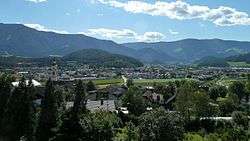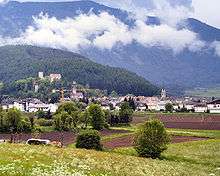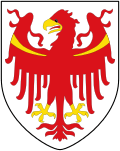Bruneck
| Bruneck | ||
|---|---|---|
| Comune | ||
|
Stadtgemeinde Bruneck Città di Brunico | ||
 | ||
| ||
 Bruneck Location of Bruneck in Italy | ||
| Coordinates: 46°48′N 11°56′E / 46.800°N 11.933°ECoordinates: 46°48′N 11°56′E / 46.800°N 11.933°E | ||
| Country | Italy | |
| Region | Trentino-Alto Adige/Südtirol | |
| Province / Metropolitan city | South Tyrol (BZ) | |
| Frazioni | Aufhofen (Villa Santa Caterina), Dietenheim (Teodone), Luns (Lunes), Reischach (Riscone), Stegen (Stegona), St. Georgen (San Giorgio) | |
| Government | ||
| • Mayor | Roland Griessmair | |
| Area | ||
| • Total | 45 km2 (17 sq mi) | |
| Elevation | 838 m (2,749 ft) | |
| Population (Nov. 2010) | ||
| • Total | 15,491 | |
| • Density | 340/km2 (890/sq mi) | |
| Demonym(s) |
German: Brunecker Italian: Brunicensi | |
| Time zone | CET (UTC+1) | |
| • Summer (DST) | CEST (UTC+2) | |
| Postal code | 39031 | |
| Dialing code | 0474 | |
| Website | Official website | |
Bruneck (German pronunciation: [ˈbrʊnɛk];[1] Italian: Brunico [ˈbruːniko];[2] Ladin: Bornech or Burnech; Latin: Branecium or Brunopolis) is the largest town in the Puster Valley in the Italian province of South Tyrol.
Geography

Bruneck lies at the confluence of the Ahr with the Rienz, which itself flows into the Eisack river. Here the northern Tauferer Ahrntal side valley and the southern Gadertal (Val Badia) of the Gran Ega creek join the broad Pustertal. The municipal area stretches from the slopes of the Zillertal Alps in the west to the Rieserferner Group of the High Tauern range in the east. In the south rises the Kronplatz massif, part of the Dolomites, the Bruneck Hausberg with the Messner Mountain Museum Corones building designed by Zaha Hadid on top at an elevation of 2,275 metres (7,464 ft) and a popular ski area.
The Bruneck town centre is located about 35 kilometres (22 mi) west of Brixen and 70 kilometres (43 mi) of the regional capital Bolzano on the road to the Brenner Pass. To the east, the town is 60 kilometres (37 mi) from Winnebach (part of Innichen) on the border with East Tyrol in Austria.
Linguistic distribution
According to the 2011 census, 82.47% of the population speak German, 15.24% Italian and 2.29% Ladin as first language.[3]
History
The town was probably named after its founder, the Brixen prince-bishop Bruno von Kirchberg, and first appeared as Bruneke in a deed issued on 23 February 1256. At that time, the town consisted of two rows of houses forming a narrow lane. During the turbulent times of the interregnum upon the death of the Hohenstaufen emperor Frederick II in 1250, the prince-bishop had a fortress erected above the town, which was first mentioned in 1276. The castle was significantly enlarged under Prince-Bishop Albert von Enn, who also had the town walls and moat completed until 1336.
Soon thereafter, further rows of houses were built outside the eastern gate. These led to the small Church of Our Lady (today's Church of the Assumption of Mary). The first church inside the town walls (at first only a small chapel) was built beneath the castle by the Brunecker burgher Niklas von Stuck. This church is today the Rainkirche. In 1358, Heinrich von Stuck, brother of Niklas, brother, funded the hospital/almshouse that was built in the following years. Soon the town received the right to hold a weekly market and impose high justice. A castle leader occupied the fortress as the bishop's representative.
In the 14th and 15th centuries, there was brisk trade between Augsburg and Venice. Some of the traded goods were brought through the Puster Valley and often stored long-term in Bruneck on the Ballplatz. This soon brought the town prosperity and fame. In this time, the Puster Valley painting school was founded by the painter Hans von Bruneck and others. The great masters Michael and Friedrich Pacher studied at this school. In 1500, the Puster Valley was reunited with Tyrol because of a testamentary contract between the house of Habsburg and the counts of Görz-Tirol. The town of Bruneck remained an episcopal possession.
In 1610, Bruneck, which had previously belonged to the parish of St. Lorenzen, became a parish in its own right. The first parish priest documented was Johann Herlin in 1613. In 1626, the Capuchin order came to Bruneck. The Fathers built themselves a monastery at the "Spitalangerle", which still exists today. In 1741, a convent was built by the Ursulines. On 11 April 1723, the worst fire in the town's history occurred. In Oberragen, not far from the church, a fire broke out, which was soon spread by the strong east wind across a large part of the town, mostly destroying it. During the long-lasting Napoleonic Wars the town suffered no material damage, but as a marching station went into great debt because of housing and feeding soldiers and infantrymen for many years.
After World War I, South Tyrol and so also Bruneck became part of the Italian State, getting the Italian name. The city was spared damage in World War I, but in World War II the town was bombed, leading to loss of both life and property.
Coat of arms
The emblem is a tower with a sloping roof, on an embattled wall with the silver gate lifted. The gules tower and the wall are placed on a vert hill with three peaks: the castle was built by Bishop Bruno von Kirchberg in the second half of the 13th century. The castle appeared on the coat of arms for the first time in the second half of the 15th century. The emblem was adopted in 1931.[4]
Climate
| Climate data for Brunico, Italy | |||||||||||||
|---|---|---|---|---|---|---|---|---|---|---|---|---|---|
| Month | Jan | Feb | Mar | Apr | May | Jun | Jul | Aug | Sep | Oct | Nov | Dec | Year |
| Average high °C (°F) | 0 (32) |
3 (37) |
8 (46) |
11 (52) |
16 (61) |
20 (68) |
22 (72) |
21 (70) |
16 (61) |
11 (52) |
5 (41) |
0 (32) |
11.1 (52) |
| Average low °C (°F) | −8 (18) |
−7 (19) |
−3 (27) |
0 (32) |
5 (41) |
9 (48) |
11 (52) |
10 (50) |
6 (43) |
3 (37) |
−3 (27) |
−7 (19) |
1.3 (34.4) |
| Average precipitation mm (inches) | 129.4 (5.094) |
174.7 (6.878) |
191.3 (7.531) |
52.9 (2.083) |
64.8 (2.551) |
102.1 (4.02) |
131.7 (5.185) |
100.0 (3.937) |
72.3 (2.846) |
69.9 (2.752) |
57.6 (2.268) |
125.9 (4.957) |
1,272.6 (50.102) |
| Average precipitation days | 6 | 6 | 8 | 11 | 13 | 16 | 14 | 14 | 10 | 9 | 8 | 7 | 122 |
| Source: World Weather Online[5] | |||||||||||||
Economy
After the war, industrial zones, workshops, and department stores were built, permitting the town considerable economic and geographic growth. In the 1960s, tourism was especially important to the town, resulting in the building of numerous new hotels and guest houses.
Bruneck is characterized by the manufacturing and service industries. Important tourist centers are found all around Bruneck. Especially worthy of mention is the ski resort on Kronplatz mountain. As of 22 October 2001, the day of the Italian population and employment census, Bruneck had 10,692 employed persons in 1,678 workplaces, making it the second-largest employer of the province. It lay only just after Brixen (Bressanone), which on census day employed 239 fewer people. Five companies in the town employ more than 250 people each, and five more companies employ more than 100 people each.
Tourism
All year round many famous markets and festivals take plae here. For example, the popular Stegener Market at the end of October, the largest market in Tyrol.
Accommodations
- Hotel Petrus, Skiing & Wellness Hotel at the Kronplatz in Bruneck
- Hotel Mühlgarten, Fit- & Wellness Hotel at the Kronplatz
International relations
Twin towns – Sister cities
Bruneck is twinned with:
Sports
The locality is home to HC Pustertal Wölfe, a professional ice hockey team currently playing in the country's top division, Serie A1.
Notable people
- Christof Innerhofer, alpine ski racer, world champion in super-G
- Markus Lanz, television presenter in Germany
- Nanni Moretti, film director
- Manfred Reichegger, ski mountaineer
- Karin Knapp, tennis player
Gallery
 Bruneck Cemetery
Bruneck Cemetery Pedestrian zone
Pedestrian zone Bruneck castle
Bruneck castle Bruneck castle - courtyard
Bruneck castle - courtyard
References
- ↑ Kleiner, Stefan; Knöbel, Ralf, eds. (2015). Duden: Das Aussprachewörterbuch (7 ed.). Berlin: Dudenverlag. p. 253. ISBN 978-3-411-04067-4.
- ↑ "DiPI Online - Dizionario di Pronuncia Italiana". www.dipionline.it. Retrieved 2016-12-31.
- ↑ "Volkszählung 2011/Censimento della popolazione 2011". astat info. Provincial Statistics Institute of the Autonomous Province of South Tyrol (38): 6–7. June 2012. Retrieved 2012-06-14.
- ↑ Heraldry of the World: Bruneck, ngw.nl; accessed 12 December 2014.
- ↑ "Brunico, Italy Weather Averages". World Weather Online. Retrieved July 1, 2012.
External links
![]() Media related to Bruneck at Wikimedia Commons
Media related to Bruneck at Wikimedia Commons
- (in German) (in Italian) Homepage of the municipality
- Photos from Brunico

